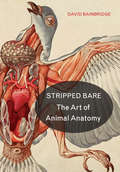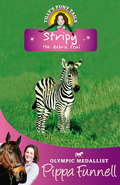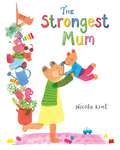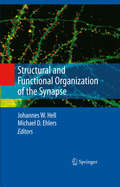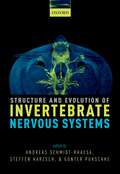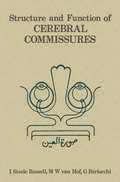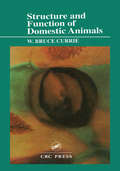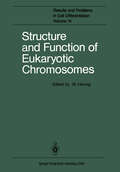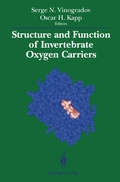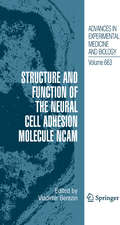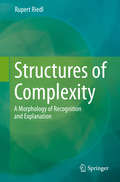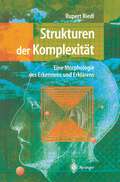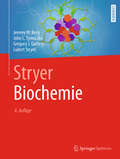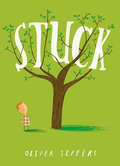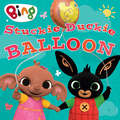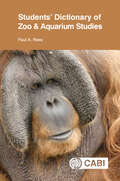- Table View
- List View
Stress lass nach!: Wie Gruppen unser Stresserleben beeinflussen
by Rolf van DickDieses leicht verständliche, unterhaltsame und humorvolle Sachbuch gibt Ihnen einen wissenschaftlich fundierten, aktuellen Überblick zum Thema Stress. Es bietet Lösungen für Ihre Probleme und zeigt auf, wie Gruppen unser Stresserleben beeinflussen. Üblicherweise heißen die Ursachen von Stresssymptomen und Burnout: individuelles Versagen, mangelnde Fähigkeiten, fehlendes Abgehärtet-sein. Deshalb wird meist der Einzelne therapiert, z.B. durch eine Rückenschule oder eine Kur. Dieses Buch bietet Ihnen mehr. Erfahren Sie von zahlreichen aktuellen Studien aus einer Vielfalt von Berufen und Lebensbereichen – von Bombenentschärfern, Schauspielern, Herzinfarktpatienten oder Altenheimbewohnern bis hin zu Fußballfans und pilgernden Hindus. Diese Studien belegen die zentrale Bedeutung von Gruppen: für den Abbau von Stress, gegenseitige Unterstützung innerhalb der Gruppe, Reduzierung von Mobbing und sogar die raschere Genesung nach Operationen. Als Leser bekommen Sie dabei ganz praktische Tipps für den Alltag – beruflich und privat.
String, Straight-edge and Shadow: The Story of Geometry
by Julia E. DigginsFrom the early peoples who marvelled at the geometry of nature -- the beehive and bird's nest -- to ancient civilisations who questioned beautiful geometric forms and asked 'why?', the story of geometry spans thousands of years. Using only three simple tools -- the string, the straight-edge and the shadow -- human beings revealed the basic principles and constructions of elementary geometry. Weaving history and legend, this fascinating book reconstructs the discoveries of mathematics's most famous figures. Through illustrations and diagrams, readers are able to follow the reasoning that lead to an ingenious proof of the Pythagorean theorem, an appreciation of the significance of the Golden Mean in art and architecture, or the construction of the five regular solids. This insightful and engaging book makes geometry accessible to everyone. Readers will be fascinated with how the knowledge and wisdom of so many cultures helped shape our civilisation today. String, Straight-edge and Shadow is also a useful and inspiring book for those teaching geometry in Steiner-Waldorf classrooms.
Stripped Bare: The Art of Animal Anatomy
by David BainbridgeA lavishly illustrated compendium of the art and history of animal anatomy from antiquity to todayFor more than two thousand years, comparative anatomy—the study of anatomical variation among different animal species—has been used to make arguments in natural philosophy, reinforce religious dogma, and remind us of our own mortality. This stunningly illustrated compendium traces the intertwined intellectual and artistic histories of comparative anatomy from antiquity to today.Stripped Bare brings together some of the most arresting images ever produced, from the earliest studies of animal form to the technicolor art of computer-generated anatomies. David Bainbridge draws on representative illustrations from different eras to discuss the philosophical, scientific, and artistic milieus from which they emerged. He vividly describes the unique aesthetics of each phase of anatomical endeavor, providing new insights into the exquisite anatomical drawings of Leonardo and Albrecht Dürer in the era before printing, Jean Héroard’s cutting and cataloging of the horse during the age of Louis XIII, the exotic pictorial menageries of the Comte de Buffon in the eighteenth century, anatomical illustrations from Charles Darwin’s voyages, the lavish symmetries of Ernst Haeckel’s prints, and much, much more.Featuring a wealth of breathtaking color illustrations throughout, Stripped Bare is a panoramic tour of the intricacies of vertebrate life as well as an expansive history of the peculiar and beautiful ways humans have attempted to study and understand the natural world.
Stripy the Zebra Foal: Book 17 (Tilly's Pony Tails #17)
by Pippa FunnellMeet Tilly Redbrow, who doesn't just love horses - she lives, breathes and dreams them too! Follow Tilly's adventures as she learns to ride and care for the horses at Silver Shoe Farm, and develops her special gift, with a little help from her favourite horse, Magic Spirit.When Tilly wins a horse safari trip to Africa, she thinks she's found her perfect holiday. And when she helps rescue abandoned zebra foal, Stripy, she knows that it's a trip she'll remember forever.For every girl who has ever longed for a pony of her own, these delightful,warm and engaging stories are packed with Pippa Funnell's expert advice on everything you ever wanted to know about horses.
Stroke Biomarkers (Neuromethods #147)
by Philip V. Peplow Bridget Martinez Svetlana A. DambinovaThis volume presents the latest data on recent achievements in new and emerging technologies for stroke biomarkers and innovations in stroke assessment. The topics discussed in this book explore the role of upcoming biomarkers in different types of stroke, and explores techniques that will allow researchers to be more effective when approaching clinical management and patient care. In Neuromethods series style, chapters include the kind of detail and key advice from the specialists needed to ensure successful results in the laboratory.Cutting-edge and comprehensive, Stroke Biomarkers is a valuable resource for both experimental and clinical scientists interested in expanding their knowledge in the field of stroke research.
The Strongest Mum
by Nicola KentMy mum is the strongest mum in the world.Little Bear is sure that no-one is as strong as his mum. She can carry anything: his bike, Zebra’s shopping, Elephant’s carpet and even . . . Flamingo’s piano! And of course, there’s ALWAYS room in her handbag for Little Bear’s treasures. But even mums can get tired and need a helping hand sometimes, as Little Bear learns when Mum takes on one thing too many, with hilarious and heart-warming consequences.The Strongest Mum is a warm, funny and original story about a parent-child relationship, perfect for learning about helping each other out. Packed full of endearing animal characters, it is sure to delight young children. Nicola Kent’s bright, jewel-like colours and eye-catching illustrations make this a truly stunning picture book debut.
Structural and Functional Organization of the Synapse
by Johannes W. Hell Michael D. EhlersThis new Springer volume, which comes complete with a free DVD, is a comprehensive and detailed overview of the synapse with emphasis on the glutamatergic synapse. Most chapters relate the synapse’s functional aspects to its molecular mechanisms. This approach shows which mechanisms are characterized on both the functional and structural level and can thus be considered firmly established. It’s an important text for neuroscientists and disease-oriented clinicians in neurology.
Structure and Evolution of Invertebrate Nervous Systems
by Günter Purschke Andreas Schmidt-Rhaesa Steffen HarzschThe nervous system is particularly fascinating for many biologists because it controls animal characteristics such as movement, behavior, and coordinated thinking. Invertebrate neurobiology has traditionally been studied in specific model organisms, whilst knowledge of the broad diversity of nervous system architecture and its evolution among metazoan animals has received less attention. This is the first major reference work in the field for 50 years, bringing together many leading evolutionary neurobiologists to review the most recent research on the structure of invertebrate nervous systems and provide a comprehensive and authoritative overview for a new generation of researchers. Presented in full colour throughout, Structure and Evolution of Invertebrate Nervous Systems synthesizes and illustrates the numerous new findings that have been made possible with light and electron microscopy. These include the recent introduction of new molecular and optical techniques such as immunohistochemical staining of neuron-specific antigens and fluorescence in-situ-hybridization, combined with visualization by confocal laser scanning microscopy. New approaches to analysing the structure of the nervous system are also included such as micro-computational tomography, cryo-soft X-ray tomography, and various 3-D visualization techniques. The book follows a systematic and phylogenetic structure, covering a broad range of taxa, interspersed with chapters focusing on selected topics in nervous system functioning which are presented as research highlights and perspectives. This comprehensive reference work will be an essential companion for graduate students and researchers alike in the fields of metazoan neurobiology, morphology, zoology, phylogeny and evolution.
Structure and Evolution of Invertebrate Nervous Systems
by Andreas Schmidt-Rhaesa Steffen Harzsch Günter PurschkeThe nervous system is particularly fascinating for many biologists because it controls animal characteristics such as movement, behavior, and coordinated thinking. Invertebrate neurobiology has traditionally been studied in specific model organisms, whilst knowledge of the broad diversity of nervous system architecture and its evolution among metazoan animals has received less attention. This is the first major reference work in the field for 50 years, bringing together many leading evolutionary neurobiologists to review the most recent research on the structure of invertebrate nervous systems and provide a comprehensive and authoritative overview for a new generation of researchers. Presented in full colour throughout, Structure and Evolution of Invertebrate Nervous Systems synthesizes and illustrates the numerous new findings that have been made possible with light and electron microscopy. These include the recent introduction of new molecular and optical techniques such as immunohistochemical staining of neuron-specific antigens and fluorescence in-situ-hybridization, combined with visualization by confocal laser scanning microscopy. New approaches to analysing the structure of the nervous system are also included such as micro-computational tomography, cryo-soft X-ray tomography, and various 3-D visualization techniques. The book follows a systematic and phylogenetic structure, covering a broad range of taxa, interspersed with chapters focusing on selected topics in nervous system functioning which are presented as research highlights and perspectives. This comprehensive reference work will be an essential companion for graduate students and researchers alike in the fields of metazoan neurobiology, morphology, zoology, phylogeny and evolution.
Structure and Function of Cholinesterases and Related Proteins
by Bhupendra P. Doctor Palmer Taylor Daniel M. Quinn Richard L. Rotundo Mary Kay GentryThe Sixth International Meeting on Cholinesterases and Related Proteins, Choli nesterases '98, was organized by Palmer Taylor and his associates at the University of California-San Diego and convened in La Jolla, California, USA, in March of 1998. This was the first conference of the series to be held in the United States, let alone on the Pa cific Rim. Nearly 200 delegates from twenty countries-from Asia, Australia, Europe, and North and South America-heard 75 oral presentations and viewed 90 posters on current research on cholinesterases and related proteins. The meeting framework was structured to include two days of plenary sessions, followed by two days of concurrent sessions and workshops in specific areas. Communication at the concurrent sessions was facilitated by the conference settings of the Martin Johnson House, on a scenic bluff overlooking the blue Pacific Ocean, and the San Diego Supercomputer Center, which enabled projection and rotation of protein structures in three dimensions for a large audience. This book is the compilation of the presentations at the Sixth International Meeting on Cholinesterases and Related Proteins into a volume that describes recent investigations on the structure, catalytic and non-catalytic functions of acetylcholinesterase (AChE), butyrylcholinesterase (BuChE), and related proteins, as well as studies on the molecular and cellular biology of these enzymes and the genes that encode them.
Structure and Function of Domestic Animals
by W. Bruce CurrieStructure and Function of Domestic Animals provides a solid introduction to the functional anatomy of domestic animals. The author covers general principles, phenomena, and mechanisms and then supports this information by providing concrete examples, giving you a working understanding of the biology of animals. Line drawings, tables, and text boxes provide supplemental information. The author examines the functions of animals from the basic to the complex. The pragmatic application of these principles allows for the raising and caring for animals with the appropriate regard for their welfare. He covers morphology, myology, electrophysiology, endocrinology, comparative anatomy, metabolism, cell growth and development, and reproductive mechanisms. The mechanism and phenomena described in this book will introduce you to the flexibility or plasticity of normal animal function. The author's pedagogical writing style clearly delineates normal function and abnormal function. Structure and Function of Domestic Animals explores many of the seemingly endless examples of the ways in which animals apply the fundamental principles of chemistry and physics to preserve their integrity. It gives you an insightful overview to a very broad subject.
Structure and Function of Domestic Animals
by W. Bruce CurrieStructure and Function of Domestic Animals provides a solid introduction to the functional anatomy of domestic animals. The author covers general principles, phenomena, and mechanisms and then supports this information by providing concrete examples, giving you a working understanding of the biology of animals. Line drawings, tables, and text boxes provide supplemental information. The author examines the functions of animals from the basic to the complex. The pragmatic application of these principles allows for the raising and caring for animals with the appropriate regard for their welfare. He covers morphology, myology, electrophysiology, endocrinology, comparative anatomy, metabolism, cell growth and development, and reproductive mechanisms. The mechanism and phenomena described in this book will introduce you to the flexibility or plasticity of normal animal function. The author's pedagogical writing style clearly delineates normal function and abnormal function. Structure and Function of Domestic Animals explores many of the seemingly endless examples of the ways in which animals apply the fundamental principles of chemistry and physics to preserve their integrity. It gives you an insightful overview to a very broad subject.
Structure and Function of Eukaryotic Chromosomes (Results and Problems in Cell Differentiation #14)
by Wolfgang HennigThis book presents an overview of various aspects of chromosome research, written by leading experts of the respective fields, combining classic and recent molecular biological results. The variety and comprehensiveness make it a handbook of chromosome research for all scientists, teachers and graduate students interested in this field. Dieses Buch faßt die unterschiedlichen Aspekte der Chromosomenforschung in Beiträgen von führenden Wissenschaftlern zusammen, wobei die klassischen Erkenntnisse mit neuesten Forschungsdaten zu einem umfassenden Überblick über das Gebiet kombiniert werden.
Structure and Function of Invertebrate Oxygen Carriers
by Serge N. Vinogradov Oscar H. KappOxygen binding proteins are large multi unit proteins ideally suited for the study of structure function relationships in biological molecules. This book, based on a Symposium at the Xth International Biophysics Congress in 1990, provides a synthesis of recent advances in our knowledge of invertebrate oxygen carriers such as hemoglobins, hemocyanins, and hemorythrins. Comprehensive reviews are combined with new research results of importance to all biochemists and molecular biologists interested in oxygen carriers in general, their gene structure and comparative biochemistry. Of particular value are the studies of invertebrate oxygen binding proteins which perform their function and have structures vastly different from the vertebrate hemoglobins and myoglobins, as well as numerous examples of modern molecular techniques as applied to research on this diverse group of proteins.
Structure and Function of the Aspartic Proteinases: Genetics, Structures, and Mechanisms (Advances in Experimental Medicine and Biology #306)
by Ben M. DunnIn September, 1990, a group of 160 scientists from 19 countries and 21 of the United States met at the Red Lion Inn in Rohnert Park, Sonoma County, California. The purpose of this meeting was to share new information from recent research on the Aspartic Proteinases. This book is a compilation of the information transferred in that forum. The Aspartic Proteinases include all those enzymes from the "fourth" class of proteolytic enzymes, the first three being the Serine, Cysteine and Metalloproteinases. Of course, all the scientists in attendance at the Sonoma Aspartic Proteinase Conference would agree that our current level of understanding of the structure and function of the Aspartic Proteinase class of enzymes is clearly first class. The reasons for this require a bit of historical perspective. The group of scientists who are engaged in study of this family of enzymes first met as a separate entity in 1976, in Norman, Oklahoma, at a meeting organized by Jordan Tang of the Oklahoma Medical Research Foundation. This was an exciting time, as the first crystal structures of some of these enzymes were described by Blundell, James and Davies. During that conference, the relationship between the two halves of the mammalian and fungal enzymes was recognized and this has provided a structural foundation for analysis of the retroviral enzymes, which came later. A book was published by Plenum Press documenting l this conference, and the current book is an update to that important work.
Structure and Function of the Neural Cell Adhesion Molecule NCAM: Structure And Function Of The Neural Cell Adhesion Molecule Ncam (Advances in Experimental Medicine and Biology #663)
by Vladimir BerezinThis book describes recent developments concerning structural, functional and possible therapeutic aspects of one particular CAM, the neural cell adhesion molecule (NCAM).
Structures of Complexity: A Morphology of Recognition and Explanation
by Rupert RiedlIn this book, the author Rupert Riedl investigates the structural and functional correlations of issues considered as "complex". He brilliantly analyzes the definition of complexity, the occurrence of complexity, the meaning of complexity, and last-but-not-least the way complexity is dealt with professionally.In recent years, our view of the world has been split into ever smaller segments – in part due to the increasing importance of the natural sciences and their associated analytical power. This calls for once again focusing on complexity and the holistic aspects, on interdisciplinary and synoptic approaches. This book is a translation of the original German version “Strukturen der Komplexität”, which was published in 2000. The discussion of complexity from the perspective of a biologist has long been overdue when it was published and is still up-to-date.
Strukturen der Komplexität: Eine Morphologie des Erkennens und Erklärens
by Rupert RiedlNicht zuletzt durch die analytischen Leistungen der Naturwissenschaften wurde unser Weltbild in immer mehr und kleinere Fraktionen zerlegt. So mag es nutzen, sich wieder um das Komplexe und Ganzheitliche zu kümmern, um Interdisziplinarität und Synoptik. In seinem neuesten Buch untersucht Rupert Riedl die Struktur- und Funktionszusammenhänge, die wir als "komplex" bezeichnen. Er analysiert auf brilliante Art und Weise die Bestimmung, das Auftreten, die Bedeutung und letztlich den fachlichen Umgang mit der Komplexität.
Stryer Biochemie
by Jeremy M. Berg John L. Tymoczko Gregory J. Gatto jr. Lubert Stryer„Oft kopiert, nie erreicht.“ Biologen heuteSeit vier Jahrzehnten prägt dieses außergewöhnliche Lehrbuch weltweit die Lehre der Biochemie. Die überaus klare und präzise Art der Darstellung, die Aktualität, die ausgefeilte Didaktik und die Verständlichkeit sind zu Markenzeichen dieses von Lehrenden wie Lernenden hoch geschätzten Standardwerkes geworden. Sie zeichnen auch die nun vorliegende achte Auflage aus, die erneut die Brücke von den biologischen und chemischen Grundlagen zu den physiologischen und medizinischen Fragestellungen schlägt. Zu den wichtigsten Neuerungen und Verbesserungen der vollständig überarbeiteten Neuauflage zählen:Kapitel 5: erweiterte Darstellung von Massenspektrometrie, Proteinmasse, Proteinidentität und ProteinsequenzKapitel 9: neuer Abschnitt zu krankheitsauslösenden Mutationen in Hämöglobingenen, neue Fallstudie zu ThalassämienKapitel 13: neue Fallstudie zu Proteinkinase-A-Mutationen und Cushing Syndrom Kapitel 14: erweiterte Darstellung zu Vorstufen von Verdauungsenzymen und zur Proteinverdauung im Dünndarm, neue Fallstudien zu Proteinverdauung im Magen und zur ZöliakieKapitel 15: neuer Abschnitt zu den Grundfunktionen des Energiestoffwechsels, erweiterte Darstellung zu Phosphaten in biochemischen ProzessenKapitel 16: neue Fallstudien zu exzessiver Fructoseaufnahme und zu schnellwachsenden Zellen und aerober GlykolyseKapitel 29: neue Fallstudien zu Phosphatidylcholin, zur Regulation des LDL-Rezeptor-Kreislaufs und zum klinischen Management von CholesterinwertenKapitel 30: neue Fallstudie zu Blutspiegelwerten der Aminotransferase als diagnostischer PrädiktorStimmen zu früheren Auflagen:Der Stryer ist der "Goldstandard" für Biochemie-Lehrbücher. Prof. Dr. Michael Rychlik, TU MünchenAktuell, didaktisch hervorragend präsentiert, bietet der "Stryer" einen umfassenden Überblick über das Feld und ist als Nachschlagewerk unverzichtbar. Prof. Dr. Dieter Adam, Universität KielDieses Lehrbuch gibt Studierenden am Anfang ihrer Ausbildung einen hervorragenden Einstieg in die Biochemie, ist aber genauso für Fortgeschrittene ideal. Prof. Dr. Mike Boysen, Universität GöttingenDer Klassiker, er ist und bleibt in der Breite und Tiefe und seinem sehr guten didaktischen Aufbau unübertroffen! Ein Muss für jeden Studierenden und Dozenten im Umfeld biomedizinischer Studiengänge. Prof. Dr. Robert Fürst, Universität FrankfurtTrotz der unglaublichen Detailfülle vermittelt der Stryer Verständnis für die Zusammenhänge in der Biochemie. Prof. Dr. Katja Gehrig, Universität Mainz Biochemie anschaulich gemacht: So sollte ein Lehrbuch sein … Dieses Buch nimmt jedem Studierenden die Angst vor der Biochemie! Prof. Dr. Wolf-Michael Weber, Universität MünsterAls Lehrbuchautor packt einen beim Studium des Stryer der Neid. So schöne Fotos, so gekonnte, bunte, eingängige Zeichnungen, soviel Grips, so wenige Fehler. Laborjournal
Stuck (Read aloud by Terence Stamp)
by Oliver JeffersThis is a read-along edition with audio synced to the text, performed by Terence Stamp. Delightful chaos ensues when a young boy gets his kite stuck up a tree in this laugh-out-loud new picture book from award-winning, internationally best-selling author-illustrator Oliver Jeffers! Narrated by Terence Stamp.
Stuckie Duckie Balloon (Bing)
by HarperCollins Children’s BooksA brilliant new picture book about sharing based on the award-winning CBeebies show Bing!
Stud: Adventures in Breeding
by Kevin ConleyEvery year, on Valentine's Day, the great Thoroughbred farms open their breeding sheds and begin their primary business. For the next one hundred and fifty days, the cries of stallions and the vigorous encouragement of their handlers echo through breeding country, from the gentle hills of Kentucky to the rich valleys of California. Stud takes us into this strange and seductive world of horse breeding. We meet the world's leading sire, Storm Cat, the Triple Crown winner, Seattle Slew, and a nearly unmanageable colt, Devil Begone, who has found peace and prosperity on the banks of the Rio Grande servicing desert mares like Patty O'Furniture. Cheap stud, top stud, old stud, wild stud, from the Hall of Fame horse to the harem stallion with his feral herd, Stud looks at intimate acts in idyllic settings and the billion-dollar business behind them.
Students' Dictionary of Zoo and Aquarium Studies
by Dr Paul ReesThis Students' Dictionary of Zoo and Aquarium Studies contains over 5,000 terms (illustrated by 88 figures) used in zoos, aquariums, safari parks, birds of prey centres, petting zoos, animal rescue centres and other facilities that make up the 'zoo industry'. It covers a wide range of topics including animal behaviour, animal husbandry, animal welfare, ecology, law, taxonomy, classification, nutrition, parasitology, physiology, reproduction, experimental design, statistics, veterinary science, disease, visitor studies, water management, wildlife conservation and zoo design and architecture. It should be of great interest to those studying zoo biology, animal management, veterinary science and related subjects along with zookeepers and aquarists in the early stages of their careers. Dr Paul Rees has a long-standing interest in animals and in zoos. He has taught a wide range of subjects including ecology, animal behaviour, zoo biology, and wildlife and zoo law. While lecturing at the University of Salford he created the first undergraduate programme in Wildlife Conservation and Zoo Biology in the United Kingdom and over a period of some 20 years was an external examiner for BSc and MSc programmes in zoo biology and wildlife conservation at the Universities of Edinburgh, Chester, Staffordshire, Wolverhampton, Gloucestershire and Nottingham Trent University. Dr Rees has published research on the large mammal fauna of Ngorongoro Crater, Tanzania, the ecology and behaviour of elephants and cheetahs living in zoos, and the laws concerning wildlife reintroductions and the regulation of zoos.
Studies in Global Animal Law (Beiträge zum ausländischen öffentlichen Recht und Völkerrecht #290)
by Anne PetersThis open access book contains 13 contributions on global animal law, preceded by an introduction which explains key concepts and methods. Global Animal Law refers to the sum of legal rules and principles (both state-made and non-state-made) governing the interaction between humans and other animals, on a domestic, local, regional, and international level. Global animal law is the response to the mismatch between almost exclusively national animal-related legislation on the one hand, and the global dimension of the animal issue on the other hand. The chapters lay some historical foundations in the ius naturae et gentium, examine various aspects of how national and international law traditionally deals with animals as commodity; and finally suggest new legal concepts and protective strategies. The book shows numerous entry points for animal issues in international law and at the same time shifts the focus and scope of inquiry.


